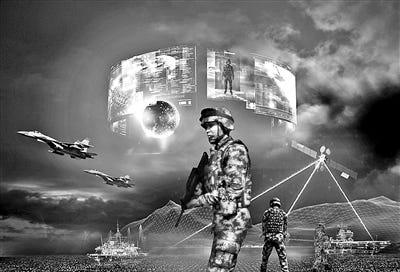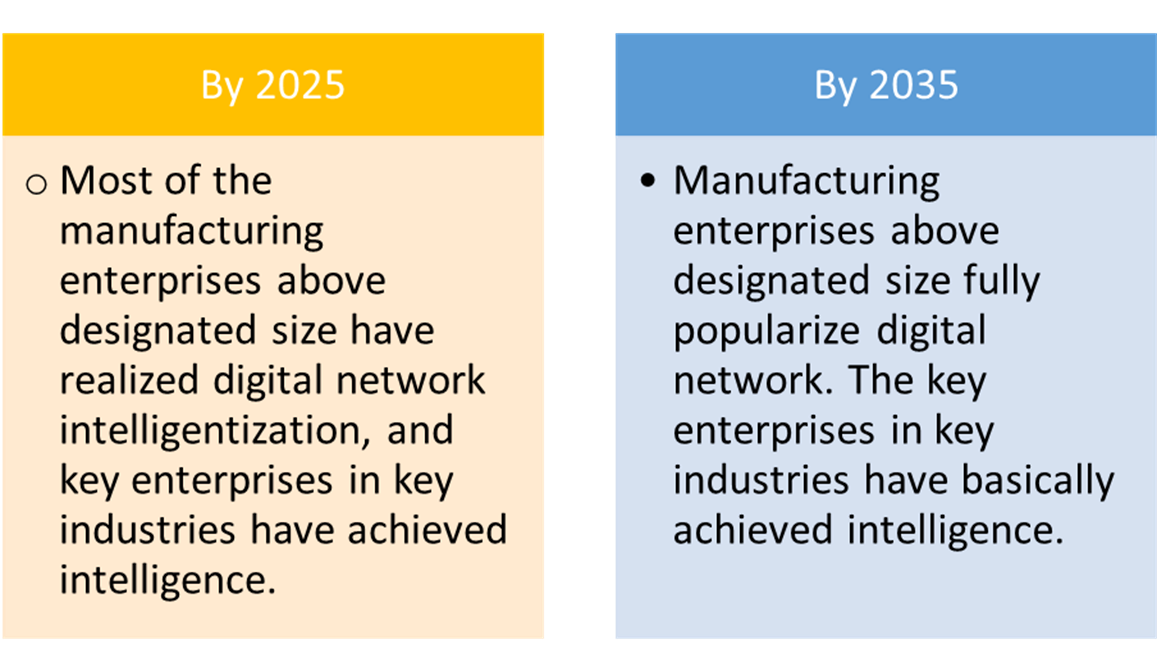Battlefield Metaverse, Intelligent Manufacturing Plan, and Platform Economy
Issue 15, 24 Jan 2022
I. Military and Warfare
"Just like the different tools in a surgeon's operating box, military means are only one way of achieving a grand strategy" — Liddell Hart, British military theorist, and strategist
Battlefield Metaverse
The evolving concept of "metaverse" has captured the attention of everyone in the world and PLA writers are not an exception. An article in last week's PLA Daily talks about "Battlefield Metaverse" (BM) (战场元宇宙 Zhànchǎng yuán yǔzhòu). This article builds upon an earlier article in PLA Daily published in Nov 2021 explaining the meaning of metaverse.
According to the authors, "Battlefield Metaverse" (BM) is the manifestation of "metaverse" in the military field. It differs from regular metaverse in some key aspects. For example, it has stricter security and confidentiality standards, more powerful simulation computing capabilities, finer real-time interaction requirements, battlefield time uniformity, real-virtual integration, boundary security, decision-making intelligence, and performance fidelity.
BM as imagined by authors needs breakthroughs in several technologies including virtual reality/augmented reality/mixed reality, digital twin technology, cloud computing, blockchain, high-speed network, artificial intelligence (AI), as also argued by the authors.
According to the authors, some basic conditions required to make BM a reality are:
Independent 'military-only' network communication: Access to BM should be limited from a few secured military network nodes in relatively fixed places or areas.
Strict identity authentication mechanism: Restrict access to military personnel who have passed the confidentiality review and military scientific research personnel with confidentiality qualifications.
Diversified user access capabilities: Users with access to BM could be divided into individual users, equipment users, and system users according to their types.
A clear command, coordination, and interaction relationship: Unlike regular metaverse, the users of BM will have designated roles and tasks.
Immersive real-time interaction capabilities: Using human-computer terminals, real users can use BM to connect with other users of BM in real time and use a variety of weapons and information systems.
Powerful AI individuals: AI individuals with intelligence and autonomous behavioral capabilities will act as permanent residents in the "Battlefield Metaverse", and can act as virtual red, blue, and third-party entities to participate in combat and training. It can also play the roles of instructors, examiners, staff officers, system operation and maintenance personnel, etc.
Realistic performance simulation capabilities: All weaponry and information systems mapped into the "Battlefield Metaverse" need to have real-world equivalent functional performance and consistent operating methods.
Flexible scene generation capabilities: The BM needs to set the battlefield area for each activity, including the geographical environment, electromagnetic environment, meteorological environment, and hydrological environment of the area.
Chinese researchers have made good progress on creating "AI individual", although current research is not applicable to the military and is purely experimental. Meet Hua Zhibing, China's first virtual student launched in 2021. I have written about China's first virtual student and the significance of this development for China's AI ambitions.
The authors further conceptualize the application of BM in military education, training, weapon simulation and testing, research, and a backup means of communication during wartime.
Additional Reading:
II. SinoSync
Intelligent Manufacturing Plan/Smart Manufacturing Plan
China's government has released several Five-year plans to be implemented during the 14th Five Year plan period. The Ministry of Industry and Information Technology (MIIT) has released some of them recently. In last week's issue, I covered National Informatization Plan. This week I am covering "14th Five-Year-Plan for the Development of Intelligent Manufacturing" (“十四五”智能制造发展规划 “Shísìwǔ” zhìnéng zhìzào fāzhǎn guīhuà).
The "14th Five-Year-Plan for the Development of Intelligent Manufacturing" (“十四五”智能制造发展规划 "Shísìwǔ” zhìnéng zhìzào fāzhǎn guīhuà ) issued by MIIT along with several other ministries and departments is linked to China's ambition of becoming a global leader in intelligent manufacturing.
Key development goals are:
The Plan proposes three sets of goals for 2025:
By 2021, transformation and upgrading should have achieved remarkable results.
70% of the manufacturing enterprises above designated size have basically achieved digital networking and built more than 500 smart manufacturing demonstration factories leading the development of the industry.
The production efficiency, product yield, energy, and resource utilization rate of manufacturing enterprises have been significantly improved, and the maturity level of intelligent manufacturing capabilities has been significantly improved.
Significantly enhance supply capacity
The technical level and market competitiveness of intelligent manufacturing equipment and industrial software have been significantly improved, and the market satisfaction rate has exceeded 70% and 50% respectively.
Cultivate more than 150 intelligent manufacturing system solution providers with high professional levels and strong service capabilities.
Build solid foundations
Build a batch of intelligent manufacturing innovation carriers and public service platforms.
Build a standard system and network infrastructure suitable for the development of intelligent manufacturing.
Complete the formulation and revision of more than 200 national and industry standards
Build more than 120 industrial Internet platforms with industry and regional influence.
To achieve these goals, the Plan has highlighted four key tasks focussing on innovation, application, supply, and support.
This intelligent manufacturing plan reads a lot like the goals of “Made in China 2025” (MIC2025) plan. However, the MIC2025 was more detailed and the goals for each sector were clearly priotized. The Intelligent Manufacturng Plan reflects China’s need and ambition to stay ahead in the global competition to lead manufacturing. In 2016, China had unveiled another Five-Year plan at the World Intelligent Manufacturing Summit.
Chinese companies believe this upgrade is necessary for China since the dividends from current labour force are tapering off.
Development of "Platform Economy"
National Development Reforms Council (国家发展和改革委员会 Gònghéguó Guójiā Fāzhǎn hé Gǎigé Wěiyuánhuì ) along with other departments released a document on promoting the development of "platform economy" (平台经济 Píngtái jīngjì). The "platform economy" (平台经济 Píngtái jīngjì) as defined in the document as a type of economy based on the "Internet platform as the main carrier."
Some of the features of "platform economy" are:
Data as the key production factor.
New-generation information technology as the core driving force.
Network information infrastructure is an important economic support form.
Generally, platform economy means economic activities facilitated on internet platforms. For example, Amazon is a platform that facilitates e-commerce.
The contents of the document can be roughly categorized into three themes:
Development and regulation
Improving supervision
Focus on high-quality development of economy (includes encouraging platform enterprises to increase investment in "hard technology" and improve international competitiveness)
To promote the development of a healthy "platform economy", the document highlights the following measures:
The document builds upon the goal of "Digital China" as envisioned under the 14th Five-Year Plan (2020-2025). The Digital China initiative aims to build a digital economy, digital society, digital government, and a healthy digital ecosystem. As per the 14th-Five-Year-Plan (2020-2025), building digital China includes innovation and application of key digital technologies, development of digital industries, digital transformation of traditional industries, open access and sharing public data, IT-enabled government services, data protection, and regulation, etc.
The Chinese government has already initiated some measures mentioned in this document. For example, one of the measures to promote a healthy platform economy mentioned in the document is "clarify the boundaries of platform responsibility and strengthen the responsibility of super-large Internet platforms." In 2021, the State Administration for Market Regulation (SAMR) issued a notification officially classifying the internet platforms into super-large, large, and small-medium platforms. The SAMR guidelines also classified internet platforms into six types. At the same time, SAMR also released a draft of guidelines of responsibilities of internet platforms, especially the super larger platforms which have an advantage over larger, medium, and small platforms. I have covered both these guidelines in Issue 5 of China Tech Dispatch.
Additional Reading:
III. InfoBytes
Metaverse
To simply put, a metaverse is a virtual world that mimics the real world and can be accessed by real people using specialized human-computer interaction tools. The virtual world can be real or fictional. The closest example I can think of is the "Second Life" universe launched in 2003. The exact meaning of metaverse is still evolving. Nonetheless, it has fuelled the imaginations of a lot of people.
This term has gained traction recently since a lot of tech giants have taken interest in building metaverse. For example, in 2021, Facebook rebranded itself as "Meta" and its founder Mark Zuckerberg announced the intention to create a "metaverse." Many companies are now joining the fray. Microsoft's recently acquired gaming company Activision Blizzard is believed in hopes of building a metaverse.
Additional Reading:
Megha Pardhi is a Research Analyst at The Takshashila Institution. She tweets at @pardhimegha21.






